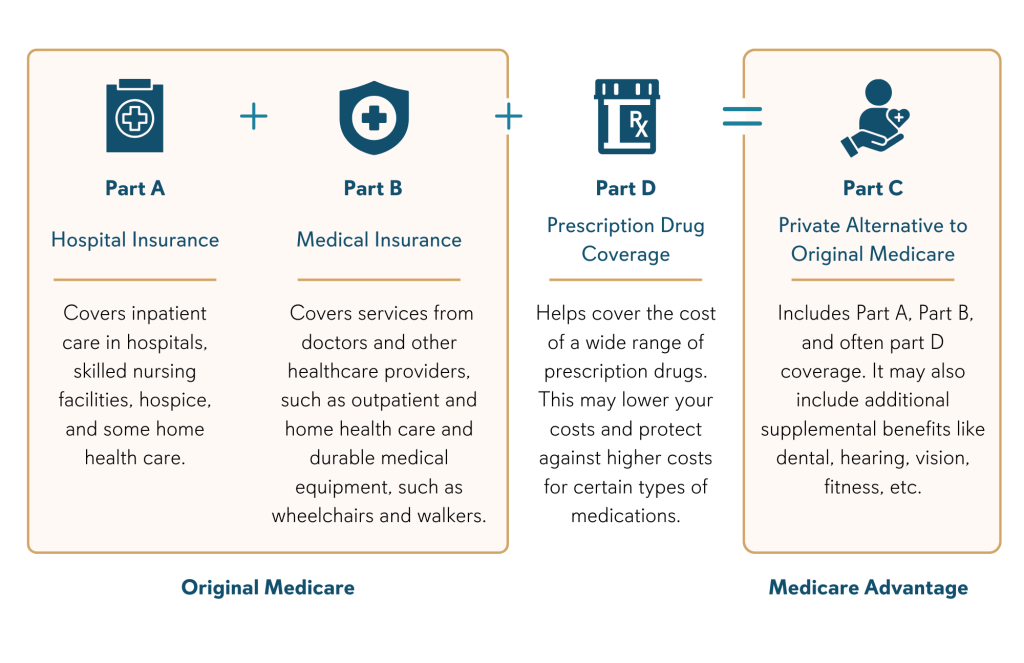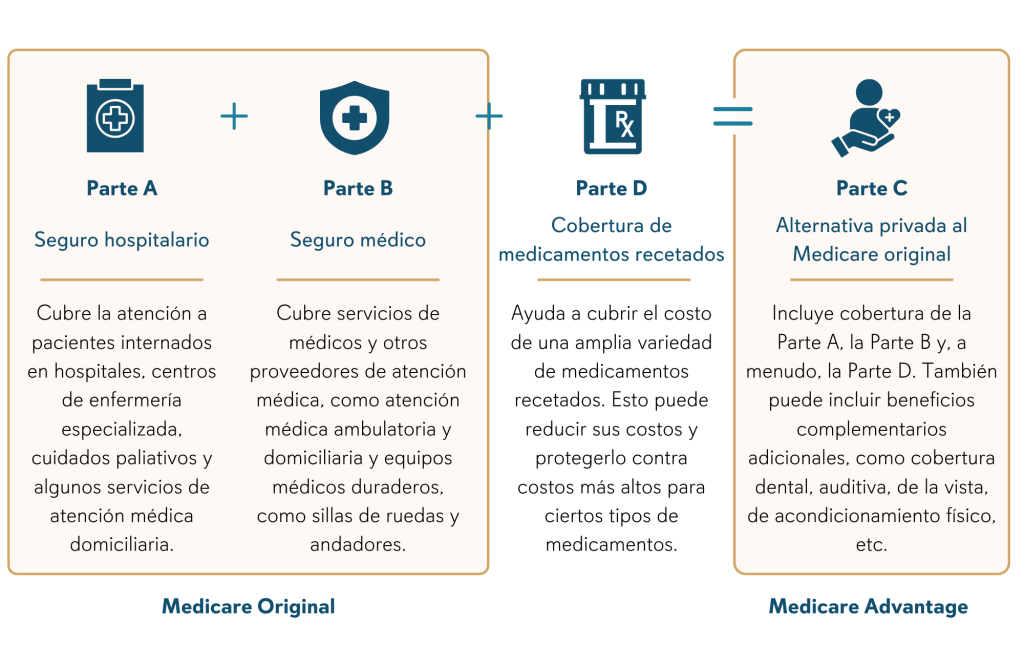Medicare Advantage plans are becoming a popular choice among seniors. In 2023, nearly 31 million people were enrolled in a Medicare Advantage plan, accounting for 51% of the eligible Medicare population[1]. To understand the options and plans available to you, it is important to understand the difference between Original Medicare and Medicare Advantage plans.
Health insurance can be an intimidating and complex topic, and we’re here to help you understand the As, Bs, Cs, and Ds of Medicare to simplify your healthcare journey.
Medicare is federal health insurance for people 65 or older and for people under 65 with certain disabilities or conditions. It is different from Medicaid, which is a joint federal and state program for people with limited income and resources. Each state runs its own Medicaid program with state-defined eligibility requirements and benefits. Because Medicare is a federal program, it includes standards for costs and coverage that are the same regardless of the state in which they live.
The main differences between Original Medicare and Medicare Advantage plans are cost, coverage, and doctor and hospital choice. In this 2-part blog series, we’ll explore all three topics. Let’s start with the basics.
The As, Bs, Cs, and Ds of Medicare Advantage
Medicare Advantage (MA) plans, also called “Part C” plans, are private health insurance plans that provide members with Part A and Part B coverage. They may also offer Part D (prescription drug) coverage and additional supplemental benefits, although the actual benefits and coverage amounts will differ depending on the insurance provider.
What does the Medicare alphabet soup mean?


Part C plans are available to those with Medicare Part A and Part B, and there are several types of Medicare Advantage plans. Some plan types are only available under certain circumstances, such as having a specific condition, and the coverage you receive may vary from plan to plan. You can learn more about each type of Medicare Advantage plan through Medicare.gov (click here).
Now that we’ve covered the As, Bs, Cs, and Ds of Medicare, let’s review the various components of Medicare Advantage plans and how they compare to Original Medicare.
The 3 Cs of Medicare Advantage
Choice
Through Original Medicare, you can go to any doctor or hospital in the U.S. that accepts Medicare insurance. However, you may need a referral to see a specialist in some cases. In comparison, using a Medicare Advantage plan might restrict you to using only the doctors and other providers that are within that specific plan’s network and service area (known as “in network”). You also may need a referral to see a specialist, although this is dependent on the specific Medicare Advantage plan and the rules of the insurance provider offering the plan.
Coverage
Original Medicare covers most medically necessary services and supplies in hospitals, doctors’ offices, and other healthcare facilities. Medicare Advantage plans must cover those same necessary services and may also provide additional benefits, such as dental, vision, and hearing services, in-home support services, or fitness benefits.
Under Original Medicare, prescription drug coverage is available through a separate Medicare drug plan – this is the Part D we covered in our ABCs above. Most Medicare Advantage plans include Part D, but the specific drug coverage will vary from plan to plan. If coverage for specific medications is an important factor in your decision about which plan or insurer you choose, it’s important to understand common Part D terms and the associated costs that could impact you.
For an in-depth guide to prescription drug coverage under Medicare Advantage plans, we will soon release Part 2 of our Guide to Navigating Medicare Advantage Plans.
Cost
At a minimum, you will pay a monthly Part B premium under Original Medicare. This premium is usually automatically deducted from your monthly Social Security check. If you need a Medicare drug plan, you’ll have a second premium for the Part D coverage. With a Medicare Advantage plan, you may still pay a monthly Part B premium, and you may have an additional premium specific to the plan. However, some health plans, such as Gold Kidney Health Plan, offer a $0 premium and some plans also provide an offset of the Part B premium through a rebate amount.
Once you’ve met your deductible under Original Medicare, you will usually pay 20% of the Medicare-approved amount for Part B-covered services with no annual limit on your out-of-pocket amount – unless you have Medigap or a similar supplemental coverage. In comparison, all Medicare Advantage plans have an annual limit on your maximum out-of-pocket costs (MOOP) for Part A and B services, and you’ll pay nothing for associated services after you’ve reached your MOOP amount.
We hope the ABC and Ds of Medicare have helped you understand how Original Medicare and Medicare Advantage plans work and the benefits included in each. If we can help answer any questions or if you would like to learn more about Gold Kidney Medicare Advantage plan benefits and coverage options available, please contact us at (844) 294-6535 (TTY: 711) or fill out this form and a representative will assist you.
To explore our plans on your own, click your state below:
Stay tuned for more information about Part D!
Y0171_Blog_MedicareABCs_1124C
Resources:
[1] https://www.kff.org/medicare/issue-brief/medicare-advantage-in-2023-enrollment-update-and-key-trends/





